Acer Chromebook Spin 311 (CP311-3H) review – two days of battery life thanks to the ARM SoC
 Well, the Chromebook family has just expanded. While a lot of manufacturers are trying to bring performance to the Chrome OS, today we are going to concentrate on a rather budget solution. It doesn’t feature a fancy Core iX processor, nor a crazy graphics card. Instead, Acer has opted for an unpretentious, energy-efficient MediaTek SoC, paired with a Mali GPU.
Well, the Chromebook family has just expanded. While a lot of manufacturers are trying to bring performance to the Chrome OS, today we are going to concentrate on a rather budget solution. It doesn’t feature a fancy Core iX processor, nor a crazy graphics card. Instead, Acer has opted for an unpretentious, energy-efficient MediaTek SoC, paired with a Mali GPU.
In addition to that, you get a convertible body, fitted with an 11.6″ IPS display with a 768p resolution. This means you get quite a portable device, with basically a desktop version of Android. Moreover, it can be used as a tablet and a great little assistant for school.
So let’s see what does the Chrome OS installed on this device has to offer, and are you actually going to need time getting used to it.
You can check the prices and configurations in our Specs System: https://laptopmedia.com/series/acer-chromebook-spin-311-cp311-3h/
Contents
Specs Sheet
- Display
- 11.6”, HD (1366 x 768), IPS
- HDD/SSD
- up to 64GB SSD
- RAM
- up to 4GB
- OS
- Chrome OS
- Battery
- 38Wh, 3-cell
- Dimensions
- 290 x 206 x 18.8 mm (11.42" x 8.11" x 0.74")
- Weight
- 1.05 kg (2.3 lbs)
- Ports and connectivity
- 1x USB Type-A
- 1x USB Type-C
- Wi-Fi
- 802.11ac
- Bluetooth
- 4.2
- Audio jack
- 3.5 mm combo
- Features
- Fingerprint reader
- optional
- Web camera
- HD
- Backlit keyboard
- optional
- Microphone
- Digital Microphone
- Speakers
- 2 Stereo Speakers
- Optical drive
- Security Lock slot
All Acer Chromebook Spin 311 (CP311-3H) configurations
What’s in the box?
Inside the box we found a 45Wh USB Type-C power adapter, as well as a stylus, and the mandatory paper manuals.
Design and construction
Now the Acer Chromebook Spin 311 (CP311-3H) is extremely similar to the CP311-2H. Ultimately, the differences lie in the lack of a second camera and the design features, taken from the 2020 Swift 3 notebooks. Additionally, the laptop feels a little thicker than what we’d like to see from an 11-incher – 20mm, and the build is entirely made out of plastic.
Expectedly, you won’t be able to open the laptop with a single hand. However, this is immediately countered by the 360-degrees movement of the hinges. You can basically use this device as a table, as a basic laptop or in tent mode. As you can see, the bezels are pretty big all around the screen, but on the bright side, there is a Gorilla Glass cover on top of it, so it shouldn’t break easily when dropped.
Being the same as last year, the keyboard brings the same pros and cons. Although the key travel is long, and the sizing of the keycaps is actually good, the inconsistency of the clicks, themselves, makes the keyboard uncomfortable for long typing sessions.
Speakers here are placed on the bottom plate, and we didn’t see any ventilation grills on the bottom plate.
Ports
This laptop is not what we would describe as rich in I/O. It only has one USB Type-C, which can be used for charging and outputting video connection, a headphone jack, and a USB Type-A 3.1 (Gen. 1) port. On the left, you’ll find the Power button, while on the right there is the volume rocker.
Disassembly, upgrade options and maintenance
In order to open the bottom plate of this device, you need to unscrew 12 Phillips-head screws. Then, use a plastic pry tool to gently pop the panel out of the chassis.
To no surprise, we see a lack of a fan, making the device completely silent. Sadly, the motherboard is turned upside down, and we don’t have visual on the cooling solution. Additionally, you will be able to upgrade neither the memory nor the storage. However, it uses 4GB of LPDDR4 memory, as well as 32GB of eMMC storage.
In this image, you can see the soldered Wi-Fi card, made by Qualcomm. It has a model number QCNFA324. Its main responsibility is the wireless and Bluetooth connectivity, supporting WiFi 802.11ac.
While the battery is only a 36Wh unit, it should deliver a decent screen on time, thanks to the efficient chipset.
Display quality
Acer Chromebook Spin 311 (CP311-3H) is equipped with a touchscreen IPS panel. Its diagonal is 11.6-inch (29.5 cm), and the resolution – 1366 х 768p. Additionally, the screen ratio is 16:9, the pixel density – 135 ppi, their pitch – 0.19 х 0.19 mm. The screen can be considered Retina when viewed from at least 64 cm (from this distance, the average human eye can’t see the individual pixels).
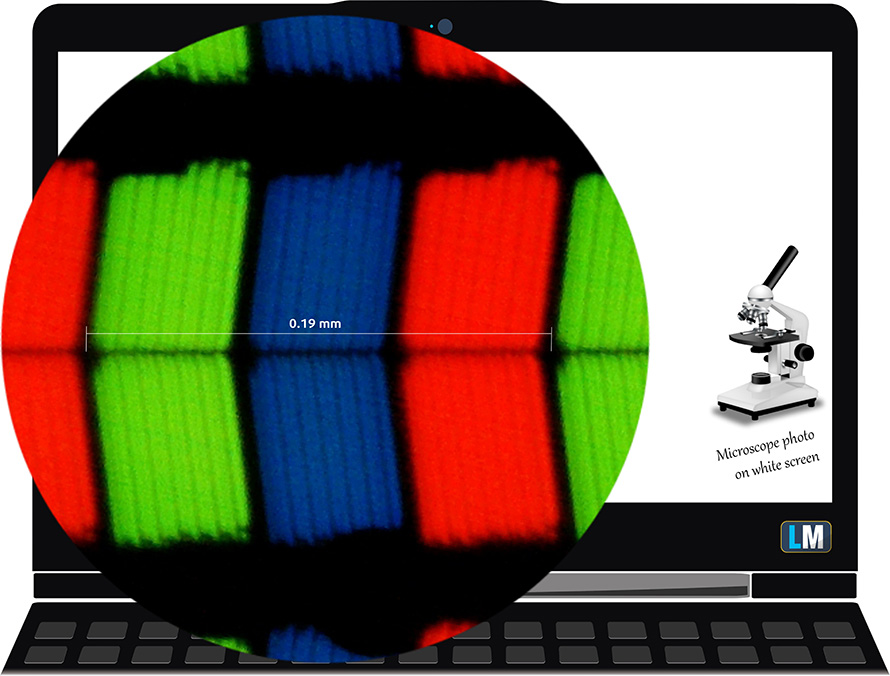
Viewing angles are comfortable. We offer images at different angles to evaluate the quality.

The maximum measured brightness is 296 nits (cd/m2) in the middle of the screen and 274 nits (cd/m2) average across the surface with a maximum deviation of 13%. The Correlated Color Temperature on a white screen and at maximum brightness is 6280K – slightly warmer than the 6500K temperature for sRGB.
In the illustration below you can see how the display performs from uniformity perspective. The illustration below shows how matters are for operational brightness levels (approximately 140 nits) – in this particular case at 69% Brightness (White level = 143 cd/m2, Black level = 0.11 cd/m2).
Values of dE2000 over 4.0 should not occur, and this parameter is one of the first you should check if you intend to use the laptop for color-sensitive work (a maximum tolerance of 2.0 ). The contrast ratio is excellent – 1340:1.
To make sure we are on the same page, we would like to give you a little introduction to the sRGB color gamut and the Adobe RGB. To start, there’s the CIE 1976 Uniform Chromaticity Diagram that represents the visible specter of colors by the human eye, giving you a better perception of the color gamut coverage and the color accuracy.
Inside the black triangle, you will see the standard color gamut (sRGB) that is being used by millions of people in HDTV and on the web. As for the Adobe RGB, this is used in professional cameras, monitors, etc for printing. Basically, colors inside the black triangle are used by everyone and this is the essential part of the color quality and color accuracy of a mainstream notebook.
Still, we’ve included other color spaces like the famous DCI-P3 standard used by movie studios, as well as the digital UHD Rec.2020 standard. Rec.2020, however, is still a thing of the future and it’s difficult for today’s displays to cover that well. We’ve also included the so-called Michael Pointer gamut, or Pointer’s gamut, which represents the colors that naturally occur around us every day.
The yellow dotted line shows Acer Chromebook Spin 311 (CP311-3H)’s color gamut coverage.
Its display covers 54% of the sRGB/ITU-R BT.709 (web/HDTV standard) in CIE1976.

We tested the accuracy of the display with 24 commonly used colors like light and dark human skin, blue sky, green grass, orange, etc.
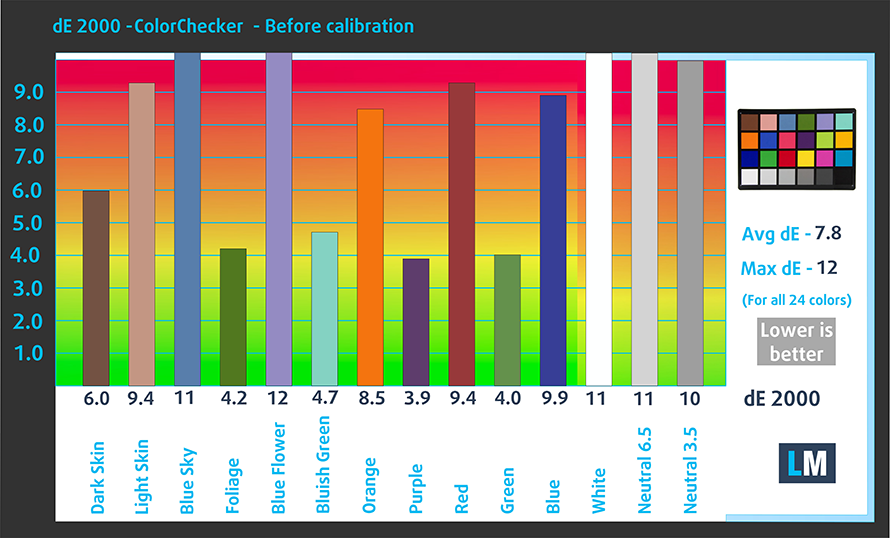
Response time (Gaming capabilities)
We test the reaction time of the pixels with the usual “black-to-white” and “white-to-black” method from 10% to 90% and vice versa.
We recorded Fall Time + Rise Time = 25 ms.
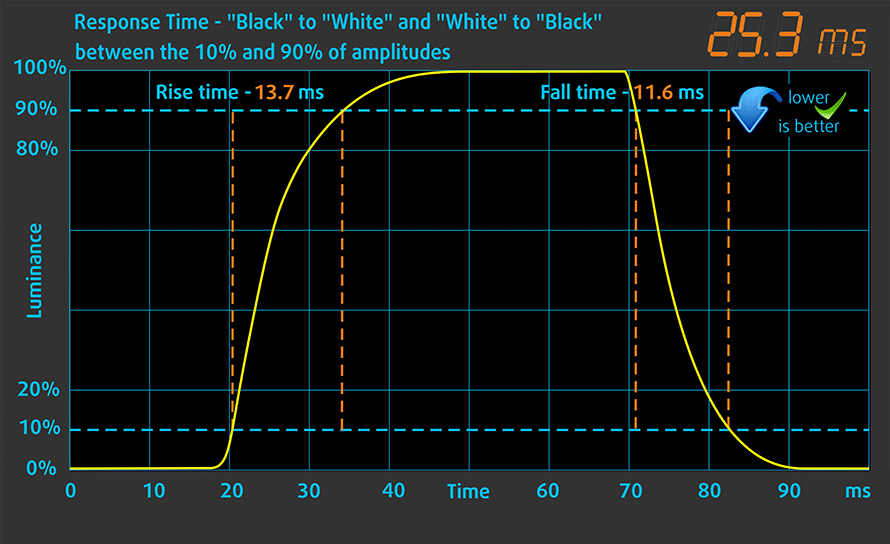
Health impact – PWM / Blue Light
PWM (Screen flickering)
Pulse-width modulation (PWM) is an easy way to control monitor brightness. When you lower the brightness, the light intensity of the backlight is not lowered, but instead turned off and on by the electronics with a frequency indistinguishable to the human eye. In these light impulses, the light/no-light time ratio varies, while brightness remains unchanged, which is harmful to your eyes. You can read more about that in our dedicated article on PWM.
Acer Chromebook Spin 311 (CP311-3H)’s backlight uses PWM until 74 nits and with a high frequency. This makes it comfortable for long periods of use, without being harmful to your eyes in this aspect.

Conclusion
Acer Chromebook Spin 311 (CP311-3H)’s display has an IPS panel with wide viewing angles, good contrast ratio, and a comfortable backlight in terms of PWM. Its disadvantage is the modest color coverage.
Sound
Acer Chromebook Spin 311 (CP311-3H) produces a quiet sound with relatively good quality. Its low, mid, and high tones are clear of deviations.
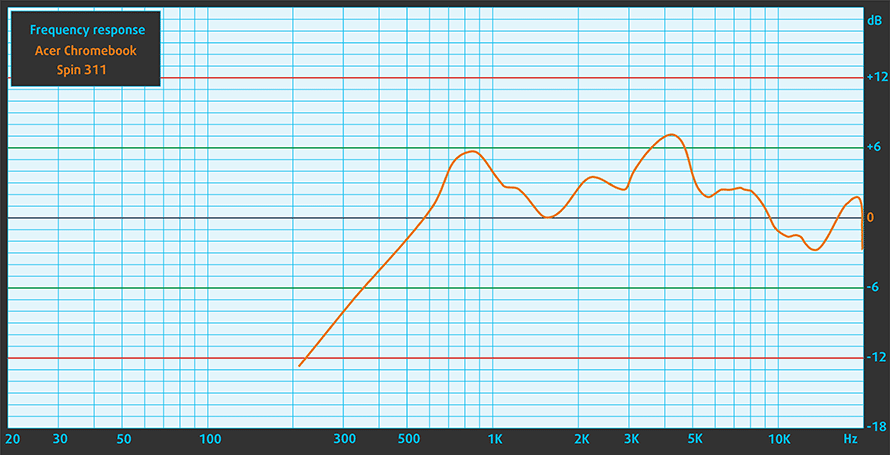
Software
Acer Chromebook Spin 311 (CP311-3H) comes with everything preinstalled and will download updates automatically, when available. Our unit’s version of Chrome OS is 82.0.4085.6 and it is based on Android 9.0.
Battery
Now, we conduct the battery tests with Windows Better performance setting turned on, screen brightness adjusted to 120 nits, and all other programs turned off except for the one we are testing the notebook with. The 36Wh battery was able to deliver 20 hours of Web browsing and 19 hours and 20 minutes of video playback.
In order to simulate real-life conditions, we used our own script for automatic web browsing through over 70 websites.
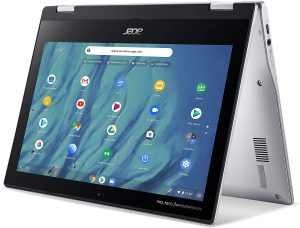
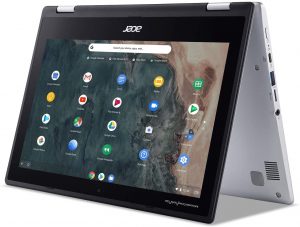

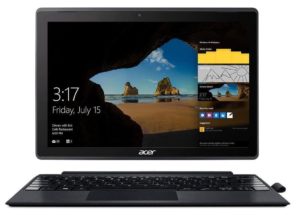
For every test like this, we use the same video in HD.




CPU options
This laptop has an ARM-based SoC. It is the Mediatek MT8183 and has 8-cores. As part of the ARM architecture, the MT8183 uses a big.LITTLE configuration of four Cortex-A73 and four Cortex-A53 cores. Ultimately, the former quartet is utilized for more power-hungry situations, while the latter is energy efficient and should drive the system for the majority of situations.
| CPU Benchmarks | single/multi Geekbench 5 | PCMark Computer Vision | Octane V2 | Mozilla Kraken 1.1 |
|---|---|---|---|---|
| Acer Chromebook Spin 11 (CP311-2H) | 378/1281 | 7122 | 15505 | 2457.7 ms |
| Acer Chromebook Spin 11 (CP311-3H) | -/- | 3411 | 9875 | 3895.0 ms |
GPU options
Its integrated ARM Mali-G72 MP3 is nowhere near the performance shown by the Intel UHD Graphics 600, seen on the predecessor. Sadly, you won’t be able to enjoy graphically-intensive games to their full potential.
| GPU Benchmarks | 3DMark Slingshot | GFXBench Manhattan 3.0 (1080p offscreen) | GFXBench Manhattan 3.1 (1080p offscreen) | GFXBench Aztec Ruins OpenGL (1080p offscreen) |
|---|---|---|---|---|
| Acer Chromebook Spin 11 (CP311-2H) | 2613 | 22 fps | 16 fps | 11 fps |
| Acer Chromebook Spin 11 (CP311-3H) | 1221 | 20 fps | 12 fps | 8 fps |
Verdict
At the end of the day, we are a little disappointed with this notebook. Yep, you have everything you need from this tablet-replacement, but when compared to its predecessor – the Chromebook Spin 311 (CP311-2H), we got a lot lower performance – both in the CPU and the GPU department.
Of course, if you mainly use Docs and Spreadsheets, this shouldn’t really bother you. But if you value speed and low latency, then you might want to divert from this unit.
When it comes to the display, though, the Acer Chromebook Spin 311 (CP311-3H) has an IPS panel with wide viewing angles, good contrast ratio, and a comfortable backlight in terms of PWM. Its disadvantage is the modest color coverage.
Honestly, this is great. We would prefer an IPS display to a budget TN one on any occasion. And moreover, we have to consider battery life. This bad boy is able to go for 20 hours of Web browsing and more than 19 hours of video playback on battery power only.
So if Chrome OS is your go-to operating system, and you need a convertible laptop for school, doing art, or just hanging around, the Chromebook Spin 311 (CP311-3H) is great. However, that’s it. No performance runs, no hardcore games, and definitely no video editing. The choice is yours.
You can check the prices and configurations in our Specs System: https://laptopmedia.com/series/acer-chromebook-spin-311-cp311-3h/
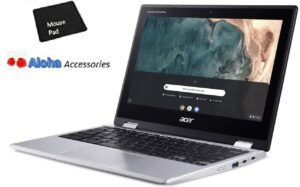
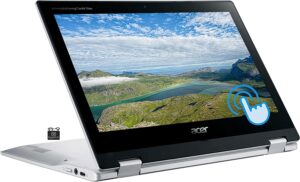
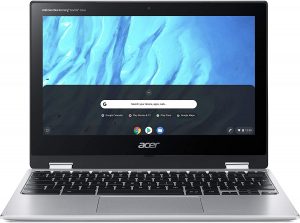
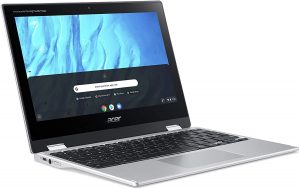

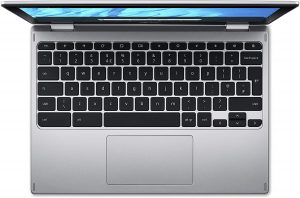
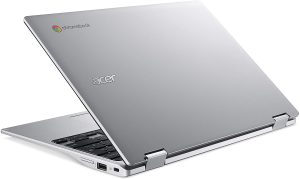

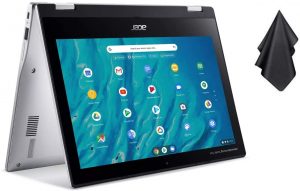
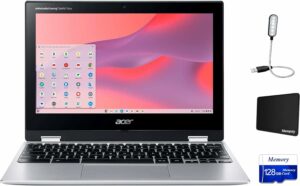
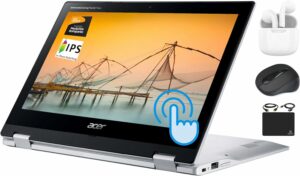
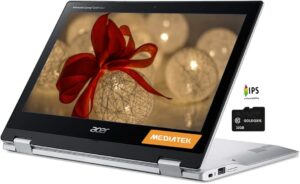
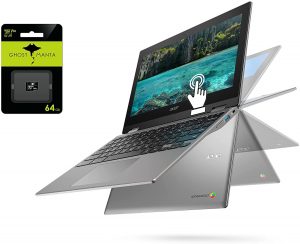
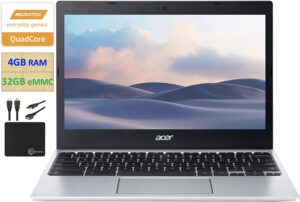

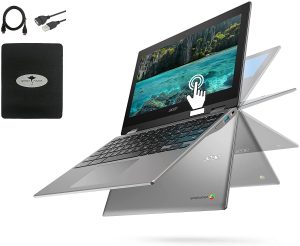




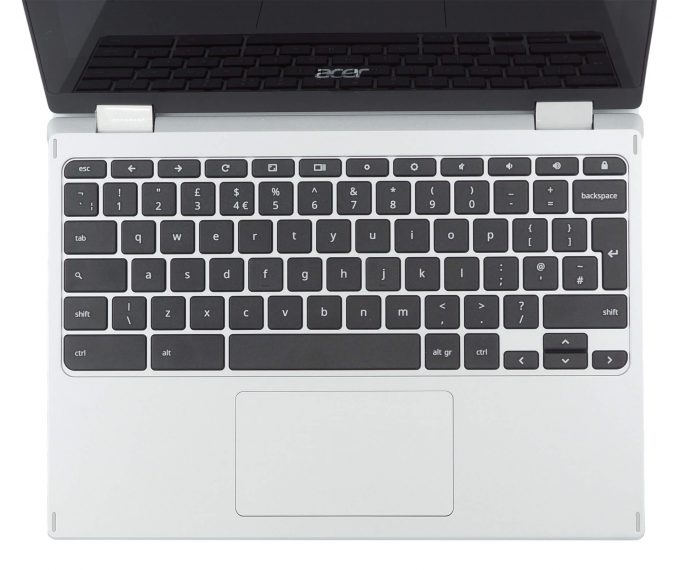
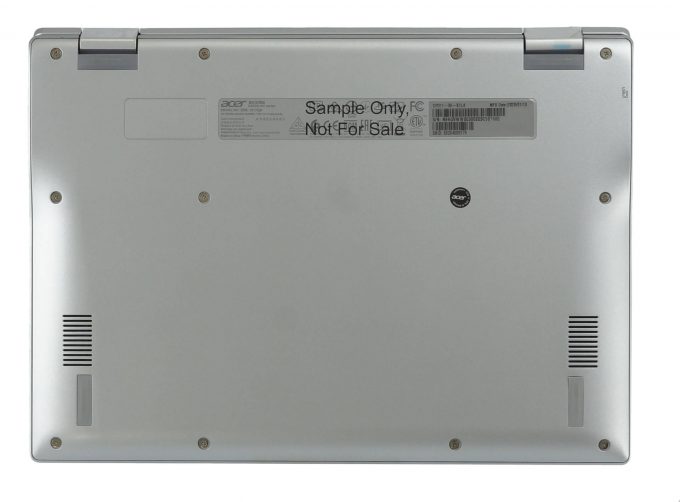



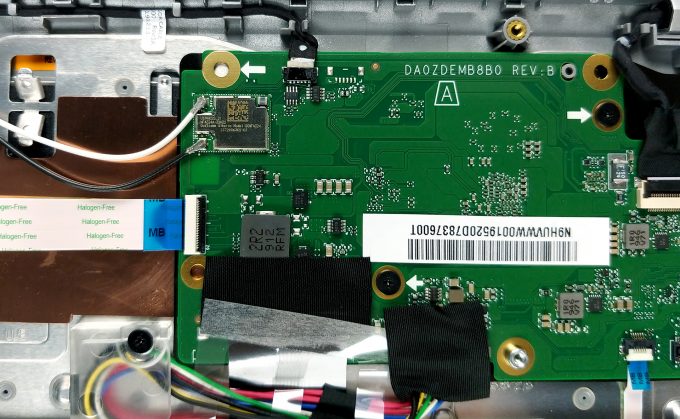
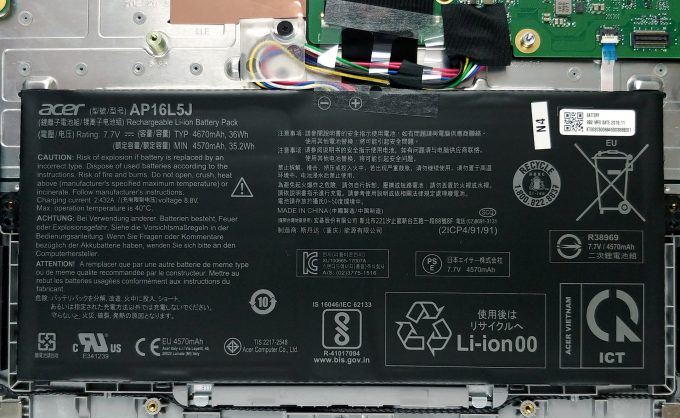
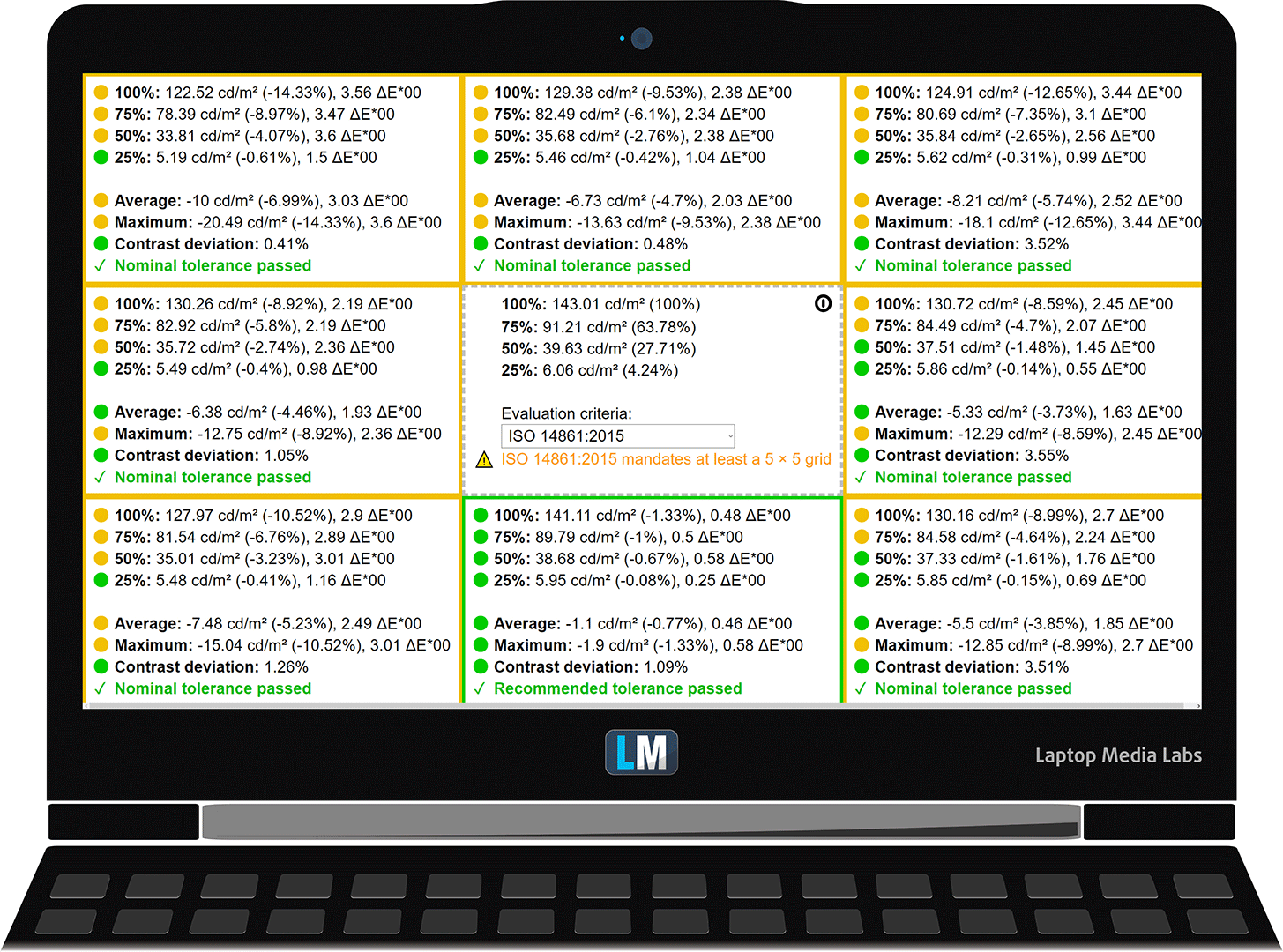








The Acer Chromebook Spin 311 is a solid and reliable device in this price range. A MediaTek chipset lends its power to the device which ensures that the performance is smooth and steady at all times and at every task at hand. The extended battery life and all the advantages of the ChomeOS are just cherry on the cake
Is the CPU upgradable at all? Can you flip the MOBO round and use a different chipset?
Can you upgrade memory and emmc?